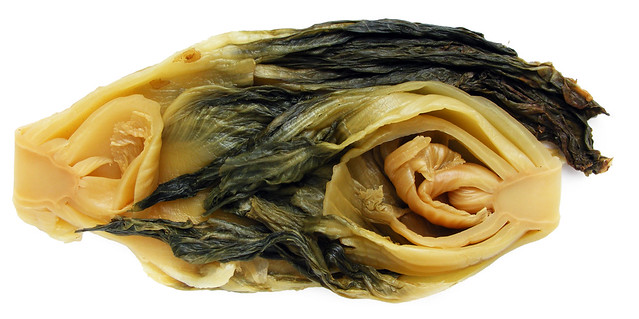
What’s it called?
Chinese sauerkraut, Chinese kimchi, pickled Mustard Greens, dưa chua (Vietnam), swan tsai / suān cài / 酸菜 (literally: sour vegetablesn) or xián cài / 鹹菜 (literally: salted vegetables) (China).
What is it?
Suan cai probably is the very first version of sauerkraut; cabbage is shortly blanched in boiling water, then sundried, sprinkled with plenty of salt, transferred to big earthenware jars and topped with weights that will slowly press out all moisture during fermentation. In the North of China they use napa cabbage (sometimes even plain, white cabbage, like in sauerkraut), in the South of China they use the less familiar jie cai (Chinese mustard cabbage). Similar to sauerkraut, suan cai tastes sour, not salty as you might expect.
How to use it?
Often sold in plastic bags. Rinse the suan cai under the tap, then leave it for a while in some water (with a dash of vinegar) to get rid of most of the excess salt. Use some chopped suan cai as topping on beef noodle soup, to flavor the filling of jiaozi, incorporate it in stir fries or simply serve it as a little side dish. It’s the suan cai that gives the typically sour edge to the broth for Northern Chinese style hotpot. Suan cai goes well with greasy pork or fish. Sealed in its bag you can keep it for months, if not years. Once opened you can still keep it quite some time, but best refrigerated.
Tips, Tricks & Recipes
- Easy recipe: making your own suan cai (with just cabbage and salt)
- Vegetarian recipe: tofu stir-fry with suan cai.
- Don’t confuse with zha cai or ya cai, also “pickled mustard cabbage “, but from a different variety and from Sichuan. Or Tianjin dong cai, pickled napa cabbage from Tianjin.

